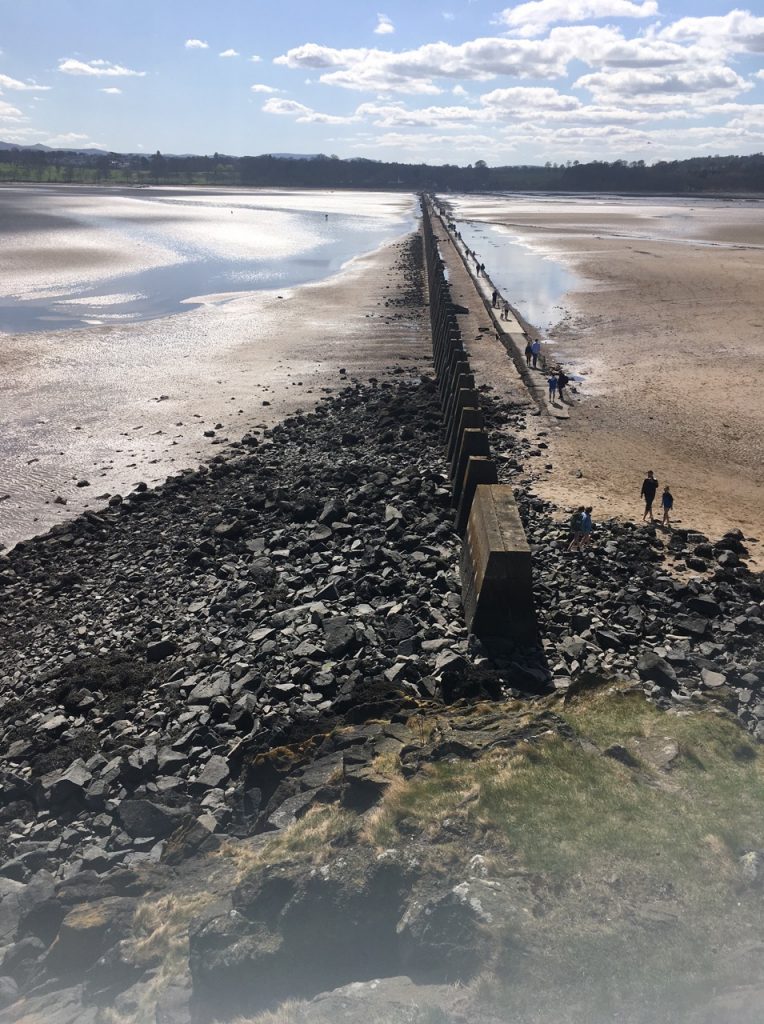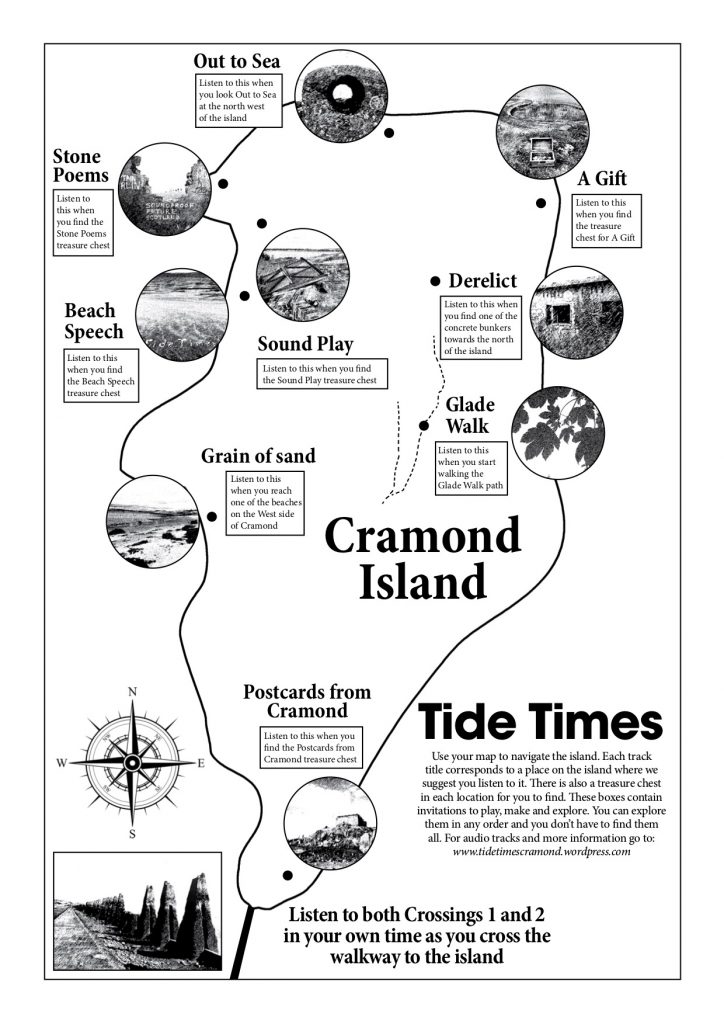Tide Times and sound mapping
Published by: Timothy Cooper
About: Pete Stollery, Timothy Cooper

Nominee Timothy Cooper writes about Tide Times and sound mapping: experiencing the sounds of our environments
In this blog I'm going to talk a little bit about a work that would be impossible to make right now, Tide Times, by Laura Bissell and I and a work that is growing out of the lockdown conditions necessary for the suppression of Covid-19, Pete Stollery’s Covid-19 Sound map.
Tide Times
In 2018 Laura and I worked to create a site responsive, experiential work made for Cramond Island. Situated in the Firth of Forth on the east coast of Scotland, the Island is connected to mainland Scotland, just north of Edinburgh, via a causeway that is crossable twice daily. During the creative process we visited Cramond five times between April and August in 2018.

Figure 1 Looking back along the causeway to the mainland from Cramond island

Figure 2 Military defenses on the Cramond causeway
The work in its original form consisted of three elements:
- ‘Treasure chests’ hidden on the island containing invitations to play, make and explore. These invite the audience members to take part in activities like writing a poem on a stone, writing a message in a bottle and writing messages on the beach. This video shows visitors responding to invitations in the ‘treasure chests’.

Figure 3 A ‘treasure chest’ nestled in a nook on Cramond Island

Figure 4 A ‘treasure chest’ with invitation printed in the lid
- Audio tracks made up of recordings of texts written by Laura and Tim, recordings of texts found on the island, and sounds recorded on the island. These were manipulated and reshaped into compositions. The audio works used ambient recordings from various locations on the island that I combined with recordings of objects we found there (like the rusty metal in the image below). The video below documents excerpts from the audio works with videos of Tide Times visitors exploring the island

Figure 5 Tim ‘playing’ rusted metal wire, it sounded satisfyingly crunchy.
- A map detailing the locations of the treasure chests and the areas the audio tracks correspond to. The idea was for the visitors to experience specific audio works and interactive works in the parts of the islands that inspired them, sharing our experience.

Figure 7 Tide Times map
Our intent in making Tide Times was to invite a deep exploration of the Island. Through reflecting on our own experiences via the audio works we wanted to share what we found. We didn’t want to tell the visitors what they should find but to suggest how they might playfully explore the island.
Looking back on this creative process I feel really lucky to have spent this time with a place in this way. It was a really beautiful way in to making the piece and I really feel like I look and listen to the world differently having made it. We chose Cramond Island not for any particular historical significance; similarly it doesn’t have any outstanding features that would see it find its way into books about the most spectacular Scottish landscapes. We chose Cramond because it had a causeway and it was local enough to visit several times. We went to Cramond looking to discover its beauty and its charm and the island gave this back to us abundantly. In making the work Laura and I often spoke about Cramond as though it was a third voice in our collaboration and we both hope that Cramond’s voice shines through our work in a beauty that is there to be read by the visitor not simply shown by us.
If you want to experience Tide Times once lockdown has eased then our website has all of the audio tracks and the invitations presented online.
www.tidetimescramond.wordpress.com
Covid-19 Sound Map
We were asked in the brief from NMS for writing these blogs to discuss works by other artists from outwith Scotland, but I hope that no one will object too strongly to me discussing Pete Stollery’s Covid-19 Sound Map. Pete is an electroacoustic composer based in Aberdeenshire, who will be known to many NMS members and supporters. Much of Pete’s work going back to the 1980s has used field recordings in some form or other and he has been interested in mapping sounds though the Gordon Soundscape and Hilton Soundscape projects.
Still Voices, a beautiful piece emerging out of the Gordon Soundscape project, uses disappearing sounds from the Glendronach Distillery from its transition from coal firing to a more ecological process. Pete worked with the distillery staff to capture sounds (both ‘loved and not so loved’) that would disappear during this operational change. Pete says that he was ‘intrigued by the potential power that I have as a composer working with technology and fixed media to conserve sounds which will soon no longer exist.’ Pete emphasises that term ‘fixed’, by recording we are fixing sounds, giving them a permanence that is not afforded by other more ephemeral art forms. But we must be careful, recording technologies don’t simply capture sounds; the microphones re-shape them, giving them a new and different character. The act of listening to a recorded sound away from its original context also allows us to attend to it in a different way, listening via loudspeakers mediating the way that we experience those sounds. It is in the play created by these relationships between sound, recording, manipulation and playback that much of Pete’s compositional work finds its aesthetic beauty. He tends to create fascinating ambiguities between his source sounds and the more surreal soundworlds that his electroacoustic works occupy. You can hear an excerpt from Still Voices on this page of Pete’s website or the complete work on his fantastic CD Scénes on the Emprintes Digitales label.
In these previous works there are elements of preservation and nostalgia and of making beautiful. Pete describes the soundcape projects as ‘sound romance’; a term borrowed from Canadian composer R. Murray Schafer. The Covid-19 sound map has a different focus. It is not romanticising lost sounds, but seeks to capture soundscapes that are changed by the effects of the virus. On the sound map you will find many references to an absence of sounds like cars or planes and the changes to sounds in specific locations. I particularly liked the sound and story of a particular lift at Inverclyde Hospital that the sound recordist had never noticed because it is usually filled with people. Another particular recording reveals the changing nature sounds of Wythenshawe Park where you can hear a woodpecker that would normally be overpowered by car sounds. This recording ends with a sound of delight, presumably from the sound recordist, there is a sense of surprise at the unfamiliar sound of the bird that I find quite moving. So perhaps the Covid-19 Sound Map is a celebration of a new-sonic-normal where human made sounds polluting the audible landscape are disappearing.
I don’t want to speculate on how the sound map will be remembered in either the short term or the long term. But the provocation it makes to listen and to observe is a beautiful invitation to attend to one of the senses that we perhaps ordinarily neglect. Pete is asking us to listen and to reflect upon the world of sound around us, contemplating and meditating upon them and opening our ears to the wonder of listening.
Having made some recordings I’d definitely encourage you to make some recordings on your phone (or any recording device you have) and send them to covid19soundmap@gmail.com. It is a wonderfully meditative experience.
Pete’s full instructions:
I’m going to build a sound map on Google Earth to capture sonic environments which have changed as a result of governments’ actions around the world to curb the spread of the virus. Examples might include recordings of empty city centres, military vehicles in streets, tannoy announcements, birdsong which can now be heard, etc.
Please send sounds (no more than 30″ in length) to covid19soundmap@gmail.com and if they’re large (no more than 20Mb please as downloads in rural Aberdeenshire are not fast at the moment!), send via a service such as WeTransfer. Please also send some text (no more than 50 words) about the sound (and how it has changed under COVID-19 constraints) and the location where you recorded it (either coordinates or describe the location).
Please take into account your own health and safety, as well as that of others, when making recordings and only record sounds during your daily permitted outing. Please follow government advice and stay safe.
Please share widely.
Websites:
https://theseatheseathesea.wordpress.com/ (Laura Bissell)
https://homepages.abdn.ac.uk/wae006/petestollery.com/en/ (Pete Stollery)
Upcoming events
- 12 Jan 2026, 12:30
[Covfefe: online monthly coffee chat for composers & musicians] - 23 Jan 2026, 18:00
[The Night With... Haptic and Stef Conner] - 25 Jan 2026, 19:30
[The Night With... Haptic and Stef Conner] - 26 Jan 2026, 12:30
[Covfefe: online monthly coffee chat for composers & musicians] - 30 Jan 2026, 20:00
[Nordic Resonance | Live performances in Malta, Shetland and Glasgow, 2026]
Recent updates
Works
- Quartet no 6 (Ma), by Matthew Whiteside
- Perihelion, by Neil Tòmas Smith
- Above the Stars, by Aileen Sweeney
Events
- Nordic Resonance | Live performances in Malta, Shetland and Glasgow, 2026
- The Night With... Haptic and Stef Conner
- The Night With... United Strings of Europe
Projects
- Aides... mémoires... Project album launch
- On a Wing and a Prayer
- On a Wing and a Prayer - presentation
Opportunities
- Noisy Nights in Glasgow – Call for Scores
- Red Note is looking for a new Chair of the Board
- In Motion 2026 - Sound and Music
